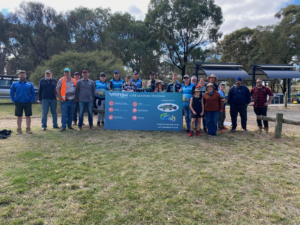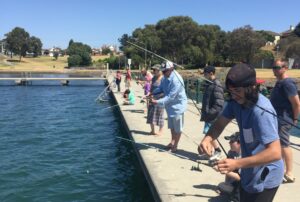March 23, 2018
The Spotted tree frog story is one which is sadly now very common in Australia. Once found right throughout the slopes of the Great Dividing Range of Victoria and NSW, these little guys are now barely clinging on to survival. So, what does a critically endangered amphibian have to do with recreational fishers I hear you ask?
The spotted tree frog shares its habitat in the mountain streams of Victoria with some of our most popular targeted freshwater fish species, such as Brown and Rainbow Trout, Redfin and Carp. And unfortunately, both the frog and tadpoles are often an easy meal for these fish. Some native fish species also predate on both the frog and tadpoles, but research carried out suggests that species such as Mountain Galaxias and Two-spined Blackfish, who have evolved with the frog over thousands of years, find them far less palatable (Gillespie, 2001). But it’s not just predation from introduced species that is causing the decline of the Spotted Tree Frog. Amphibian Chytrid fungus is believed to have arrived in Australia in the late 1970’s. It quickly spread south through Queensland, and is now found in all states and territories except the NT. It’s a deadly skin disease that has been directly implicated in the extinction of at least six frog species and the dramatic decline of at least 7 others in Australia (Skerratt et al 2016). Given the frogs bleak outlook, research scientists and conservation organizations are now doing all they can to not only protect the current populations, but find new habitat for the species to thrive. And that is where the recreational fishing community can play their part.
In late March 2017, researchers from the University of Melbourne, The Arthur Rylah Institute and Zoo’s Victoria engaged members of VRFish, the Australian Trout Foundation and Native Fish Australia, to help develop a strategy to aid in the recovery of the species. The extent of stakeholder engagement really shows how far we have come in this day and age, where conservation groups and rec anglers can work together in solidarity to achieve beneficial outcomes for all parties involved. If recreational fishing is to evolve and prosper in this state, it’s vital that we are actively involved in conservation and sustainability projects that not only increase opportunities for recreational fishing, but provide broader benefits for the community and the environment.

So right now, you’re probably thinking ‘They want to wipe out all the fish in my favourite trout stream!’ Well actually, that couldn’t be any further from the truth. In fact, many of the ideas thrown around the room at the initial meeting would have negligible impacts on recreational fishing. Some of those idea’s included exploring habitat in ‘closed water catchments’ where recreational fishing is currently not permitted, and utilising streams with natural or man-made barriers that prevent the migration of predatory fish. Brown and Rainbow trout are still our most targeted freshwater species here in Victoria and are socially and economically important to the future of recreational fishing, so it’s important to minimize and or offset any impact to recreational fishing opportunities. The conservation groups involved also recognize this and will continue to work with us toward mutually beneficial goals. It’s also hoped that some native species can be re-introduced in conjunction with the Spotted Tree frog recovery program that will actually increase opportunity for recreational fishing in the state.
So, what can you do as a recreational angler to help the Spotted Tree Frog on its road to recovery? Next time you are wading up your favourite trout stream, keep your eyes peeled for frogs. Report any Spotted Tree Frog sightings or sick looking and dead frogs to a state environment department such as DELWP. This sort of information will help VRFish and other recreational fishing groups to be part of the conversation and identify areas to protect frogs.
Above all else, when it comes to threatened or endangered species such as the Spotted Tree Frog, awareness is the key message that I ask all recreational anglers to take away. We are extremely lucky to live in one of the most bio-diverse places on earth, and our mountain rivers and streams are like no others on the planet. As anglers, we are all environmental stewards of our waterways, and it’s up to us to educate others and preserve the unique biodiversity that these precious ecosystems currently provide to us all.
Download Spotted Tree Frog flyer
References:
Department of the Environment and Energy. Chytridiomycosis (Amphibian chytrid fungus disease) – factsheet, viewed 5thApril 2017, http://www.environment.gov.au/biodiversity/invasive-species/publications/factsheet-chytridiomycosis-amphibian-chytrid-fungus-disease
Gillespie, G. (2001) The role of introduced trout in the decline of the spotted tree frog (Litoria spenceri) in south-eastern Australia. Biological Conservation100,187-198.
Phillott, A. D., R. Speare, H. B. Hines, L. F. Skerratt, E. Meyer, K. R. McDonald, S. D. Cashins, D. Mendez, and L. Berger. 2010. Minimising exposure of amphibians to pathogens during field studies. Diseases of Aquatic Organisms 92:175-185.
Skerratt, L., L. Berger, N. Clemann, D. Hunter, G. Marantelli, D. Newell, A. Philips, M. McFadden, H. Hines, B. Scheele, L. Brannelly, R. Speare, S. Versteegen, S. Cashins, and M. West. 2016. Priorities for management of chytridiomycosis in Australia: saving frogs from extinction. Wildlife research 43:105.
Zoos Victoria. Spotted Tree Frog, viewed 10thApril 2017, https://www.zoo.org.au/healesville/animals/spotted-tree-frog








